

How to Write a Book Review: The Ultimate Guide
WHAT IS A BOOK REVIEW?

Traditionally, book reviews are evaluations of a recently published book in any genre. Usually, around the 500 to 700-word mark, they briefly describe a text’s main elements while appraising the work’s strengths and weaknesses. Published book reviews can appear in newspapers, magazines, and academic journals. They provide the reader with an overview of the book itself and indicate whether or not the reviewer would recommend the book to the reader.
WHAT IS THE PURPOSE OF A BOOK REVIEW?
There was a time when book reviews were a regular appearance in every quality newspaper and many periodicals. They were essential elements in whether or not a book would sell well. A review from a heavyweight critic could often be the deciding factor in whether a book became a bestseller or a damp squib. In the last few decades, however, the book review’s influence has waned considerably, with many potential book buyers preferring to consult customer reviews on Amazon, or sites like Goodreads, before buying. As a result, book review’s appearance in newspapers, journals, and digital media has become less frequent.
WHY BOTHER TEACHING STUDENTS TO WRITE BOOK REVIEWS AT ALL?
Even in the heyday of the book review’s influence, few students who learned the craft of writing a book review became literary critics! The real value of crafting a well-written book review for a student does not lie in their ability to impact book sales. Understanding how to produce a well-written book review helps students to:
● Engage critically with a text
● Critically evaluate a text
● Respond personally to a range of different writing genres
● Improve their own reading, writing, and thinking skills.
Not to Be Confused with a Book Report!
WHAT’S THE DIFFERENCE BETWEEN A BOOK REVIEW AND A BOOK REPORT?

While the terms are often used interchangeably, there are clear differences in both the purpose and the format of the two genres. Generally speaking, book reports aim to give a more detailed outline of what occurs in a book. A book report on a work of fiction will tend to give a comprehensive account of the characters, major plot lines, and themes in the book. Book reports are usually written around the K-12 age range, while book reviews tend not to be undertaken by those at the younger end of this age range due to the need for the higher-level critical skills required in writing them. At their highest expression, book reviews are written at the college level and by professional critics.
Learn how to write a book review step by step with our complete guide for students and teachers by familiarizing yourself with the structure and features.
BOOK REVIEW STRUCTURE
ANALYZE Evaluate the book with a critical mind.
THOROUGHNESS The whole is greater than the sum of all its parts. Review the book as a WHOLE.
COMPARE Where appropriate compare to similar texts and genres.
THUMBS UP OR DOWN? You are going to have to inevitably recommend or reject this book to potential readers.
BE CONSISTENT Take a stance and stick with it throughout your review.
FEATURES OF A BOOK REVIEW
PAST TENSE You are writing about a book you have already read.
EMOTIVE LANGUAGE Whatever your stance or opinion be passionate about it. Your audience will thank you for it.
VOICE Both active and passive voice are used in recounts.
A COMPLETE UNIT ON REVIEW AND ANALYSIS OF TEXTS

⭐ Make MOVIES A MEANINGFUL PART OF YOUR CURRICULUM with this engaging collection of tasks and tools your students will love. ⭐ All the hard work is done for you with NO PREPARATION REQUIRED.
This collection of 21 INDEPENDENT TASKS and GRAPHIC ORGANIZERS takes students beyond the hype, special effects and trailers to look at visual literacy from several perspectives offering DEEP LEARNING OPPORTUNITIES by watching a SERIES, DOCUMENTARY, FILM, and even VIDEO GAMES.
ELEMENTS OF A BOOK REVIEW
As with any of the writing genres we teach our students, a book review can be helpfully explained in terms of criteria. While there is much to the ‘art’ of writing, there is also, thankfully, a lot of the nuts and bolts that can be listed too. Have students consider the following elements before writing:
● Title: Often, the title of the book review will correspond to the title of the text itself, but there may also be some examination of the title’s relevance. How does it fit into the purpose of the work as a whole? Does it convey a message or reveal larger themes explored within the work?
● Author: Within the book review, there may be some discussion of who the author is and what they have written before, especially if it relates to the current work being reviewed. There may be some mention of the author’s style and what they are best known for. If the author has received any awards or prizes, this may also be mentioned within the body of the review.
● Genre: A book review will identify the genre that the book belongs to, whether fiction or nonfiction, poetry, romance, science-fiction, history etc. The genre will likely tie in, too with who the intended audience for the book is and what the overall purpose of the work is.
● Book Jacket / Cover: Often, a book’s cover will contain artwork that is worthy of comment. It may contain interesting details related to the text that contribute to, or detract from, the work as a whole.
● Structure: The book’s structure will often be heavily informed by its genre. Have students examine how the book is organized before writing their review. Does it contain a preface from a guest editor, for example? Is it written in sections or chapters? Does it have a table of contents, index, glossary etc.? While all these details may not make it into the review itself, looking at how the book is structured may reveal some interesting aspects.
● Publisher and Price: A book review will usually contain details of who publishes the book and its cost. A review will often provide details of where the book is available too.

BOOK REVIEW KEY ELEMENTS
As students read and engage with the work they will review, they will develop a sense of the shape their review will take. This will begin with the summary. Encourage students to take notes during the reading of the work that will help them in writing the summary that will form an essential part of their review. Aspects of the book they may wish to take notes on in a work of fiction may include:
● Characters: Who are the main characters? What are their motivations? Are they convincingly drawn? Or are they empathetic characters?
● Themes: What are the main themes of the work? Are there recurring motifs in the work? Is the exploration of the themes deep or surface only?
● Style: What are the key aspects of the writer’s style? How does it fit into the wider literary world?
● Plot: What is the story’s main catalyst? What happens in the rising action? What are the story’s subplots?
A book review will generally begin with a short summary of the work itself. However, it is important not to give too much away, remind students – no spoilers, please! For nonfiction works, this may be a summary of the main arguments of the work, again, without giving too much detail away. In a work of fiction, a book review will often summarise up to the rising action of the piece without going beyond to reveal too much!

The summary should also provide some orientation for the reader. Given the nature of the purpose of a review, it is important that students’ consider their intended audience in the writing of their review. Readers will most likely not have read the book in question and will require some orientation. This is often achieved through introductions to the main characters, themes, primary arguments etc. This will help the reader to gauge whether or not the book is of interest to them.
Once your student has summarized the work, it is time to ‘review’ in earnest. At this point, the student should begin to detail their own opinion of the book. To do this well they should:
i. Make It Personal
Often when teaching essay writing we will talk to our students about the importance of climbing up and down the ladder of abstraction. Just as it is helpful to explore large, more abstract concepts in an essay by bringing it down to Earth, in a book review, it is important that students can relate the characters, themes, ideas etc to their own lives.
Book reviews are meant to be subjective. They are opinion pieces, and opinions grow out of our experiences of life. Encourage students to link the work they are writing about to their own personal life within the body of the review. By making this personal connection to the work, students contextualize their opinions for the readers and help them to understand whether the book will be of interest to them or not in the process.
ii. Make It Universal
Just as it is important to climb down the ladder of abstraction to show how the work relates to individual life, it is important to climb upwards on the ladder too. Students should endeavor to show how the ideas explored in the book relate to the wider world. The may be in the form of the universality of the underlying themes in a work of fiction or, for example, the international implications for arguments expressed in a work of nonfiction.
iii. Support Opinions with Evidence
A book review is a subjective piece of writing by its very nature. However, just because it is subjective does not mean that opinions do not need to be justified. Make sure students understand how to back up their opinions with various forms of evidence, for example, quotations, statistics, and the use of primary and secondary sources.
EDIT AND REVISE YOUR BOOK REVIEW

As with any writing genre, encourage students to polish things up with review and revision at the end. Encourage them to proofread and check for accurate spelling throughout, with particular attention to the author’s name, character names, publisher etc.
It is good practice too for students to double-check their use of evidence. Are statements supported? Are the statistics used correctly? Are the quotations from the text accurate? Mistakes such as these uncorrected can do great damage to the value of a book review as they can undermine the reader’s confidence in the writer’s judgement.
The discipline of writing book reviews offers students opportunities to develop their writing skills and exercise their critical faculties. Book reviews can be valuable standalone activities or serve as a part of a series of activities engaging with a central text. They can also serve as an effective springboard into later discussion work based on the ideas and issues explored in a particular book. Though the book review does not hold the sway it once did in the mind’s of the reading public, it still serves as an effective teaching tool in our classrooms today.

Teaching Resources
Use our resources and tools to improve your student’s writing skills through proven teaching strategies.
BOOK REVIEW GRAPHIC ORGANIZER (TEMPLATE)

101 DIGITAL & PRINT GRAPHIC ORGANIZERS FOR ALL CURRICULUM AREAS

Introduce your students to 21st-century learning with this GROWING BUNDLE OF 101 EDITABLE & PRINTABLE GRAPHIC ORGANIZERS. ✌ NO PREP REQUIRED!!! ✌ Go paperless, and let your students express their knowledge and creativity through the power of technology and collaboration inside and outside the classroom with ease.
Whilst you don’t have to have a 1:1 or BYOD classroom to benefit from this bundle, it has been purpose-built to deliver through platforms such as ✔ GOOGLE CLASSROOM, ✔ OFFICE 365, ✔ or any CLOUD-BASED LEARNING PLATFORM.
Book and Movie review writing examples (Student Writing Samples)
Below are a collection of student writing samples of book reviews. Click on the image to enlarge and explore them in greater detail. Please take a moment to both read the movie or book review in detail but also the teacher and student guides which highlight some of the key elements of writing a text review
Please understand these student writing samples are not intended to be perfect examples for each age or grade level but a piece of writing for students and teachers to explore together to critically analyze to improve student writing skills and deepen their understanding of book review writing.
We would recommend reading the example either a year above and below, as well as the grade you are currently working with to gain a broader appreciation of this text type .

BOOK REVIEW VIDEO TUTORIALS

OTHER GREAT ARTICLES RELATED TO BOOK REVIEWS

Transactional Writing

How to write a text response

How to Write a Compare and Contrast Essay

How to Write Excellent Expository Essays
Mighty Writer Blog
5 benefits of writing a book review in ks2, writing book reviews might be a classroom staple, but have you truly considered why they’re so beneficial to a child’s learning.
Contrary to popular belief, writing a book review isn’t a test of knowledge – nor should they be used to ‘prove’ that a book has been read.
It is, of course, quite difficult to review a book without reading it first. However, reducing this task to a mere confirmation tactic would be a wasted opportunity; it has a whole lot more to offer your little learners.
If you’re not sure of the wider benefits that writing book reviews can bring, don’t worry – we’ve summarised our top five below.
1. Nifty Notetaking

2. Competent Critical Thinking
Writing a book review is a chance to examine literature and digest it in a more complex way than simply following the story and understanding its plot.
Compile a list of questions to help children think critically about the book they’re reading and draw conclusions based on both facts and feelings.
For example:
- Are the characters believable? Are they somebody you would like to meet in real life?
- Do you like author’s writing style and how they use words?
- What emotions did you feel when you read the book? Which passages made you feel this way?
- Did you feel satisfied by the story’s ending?
3. Reliable Research
Learning how to properly research a topic is another skill that will serve your pupils well throughout their education.
To add further context to a review, ask the class to do a little research into the author of their chosen book. Using the author’s website, for example, could tell you about their life and other books they’ve written.
Does this make you understand the book any better or think about it differently?
4. Riveting Reflection
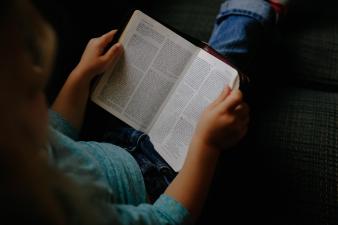
5. Impressive Influence
Peer recommendation is powerful.
When a book is positively received by a child, it’s likely to be considered by their friends – it’s the same simple science that we find with any kind of review, and a benefit that the whole class can enjoy.

Searching for More Fun Ideas to Engage your Class with Story Writing?

- Primary Hub
- Art & Design
- Design & Technology
- Health & Wellbeing
- Secondary Hub
- Citizenship
- Primary CPD
- Secondary CPD
- Book Awards
- All Products
- Primary Products
- Secondary Products
- School Trips
- Trip Directory
- Trips by Subject
- Trips by Type
- Trips by Region
- Submit a Trip Venue
Trending stories

Top results

- Book Review Templates Ks1 Ks2
Book review template – Free printable resources for KS1 & KS2
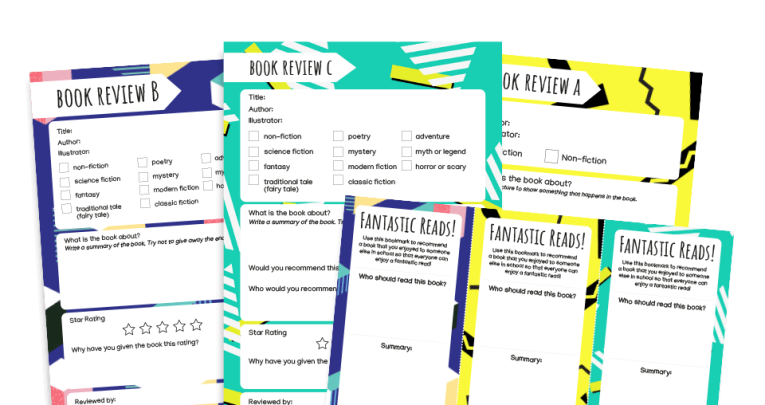
Think Fantastic Mr Fox is, well, fantastic? Wish Gangsta Granny could be retired? Help children express their views on fiction and non-fiction alike with these book review templates, worksheets and resources…

A book review is a great way for children to learn to communicate their thoughts and ideas about books they read. These book review template resources will help make students’ reviews the best they can possibly be.
You shouldn’t require children to write a book review every time they finish a book (this can be seen as punishing them for reading ). However, these templates will make it easy for children to write their review in a succinct and structured way.
Why not keep the book reviews in your classroom reading corner or library to help children choose a book based on their peers’ recommendations?
Free book review templates
How to write a book review, alternatives to writing book reviews.
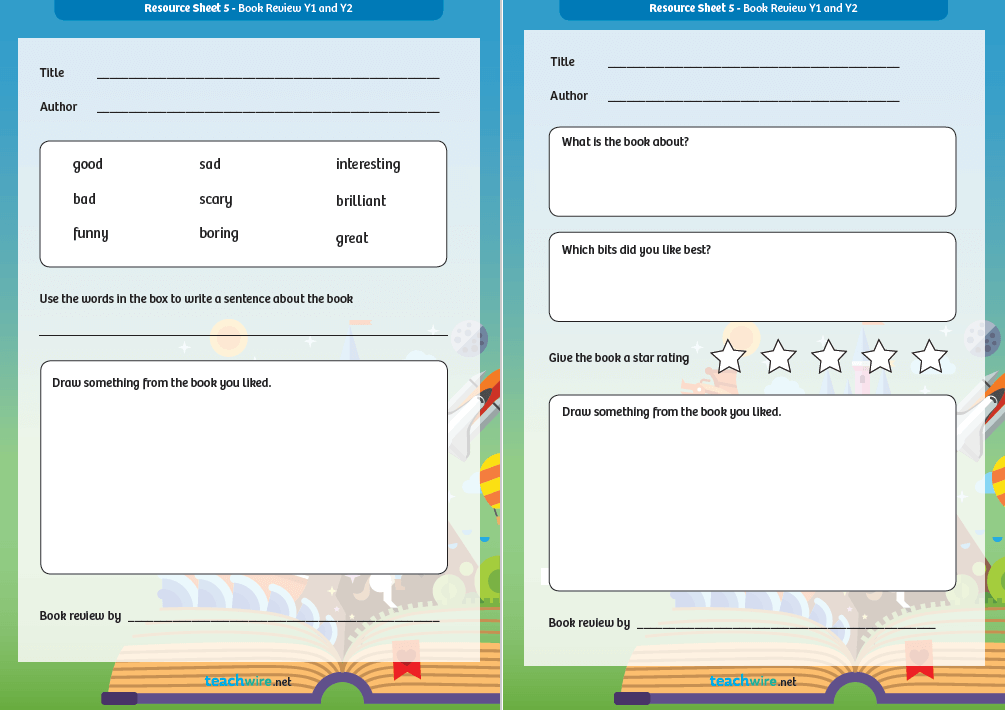
Writing book reviews enables pupils to offer opinions based on first-hand experiences. This free download, most suitable for KS1, contains three separate book review templates to choose from.
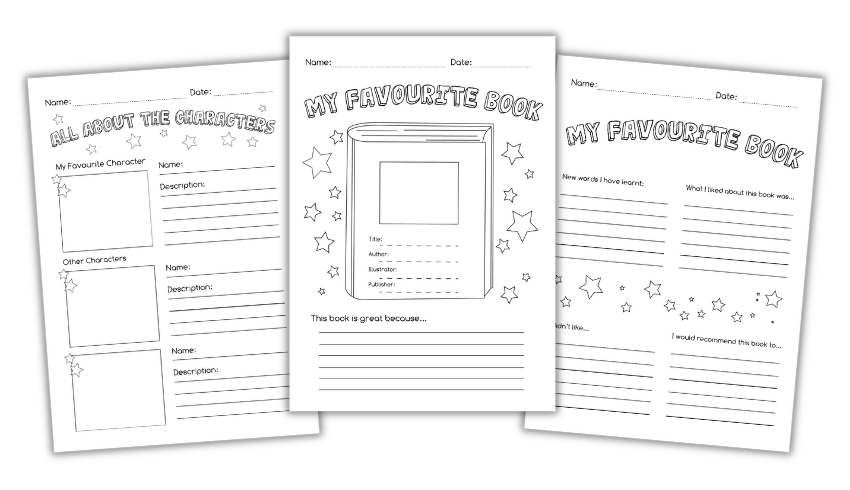
Use these free ‘My Favourite Book’ review worksheets to encourage children to talk about and recommend their favourite book to others. At the same time they’ll be improving their language and writing skills.
With this adaptable resource you can choose how many worksheets you use. Use only the first page to create a brief overview of a book. Alternatively, extend the activity by looking at character descriptions and developing higher-order thinking.
Book review templates from Plazoom
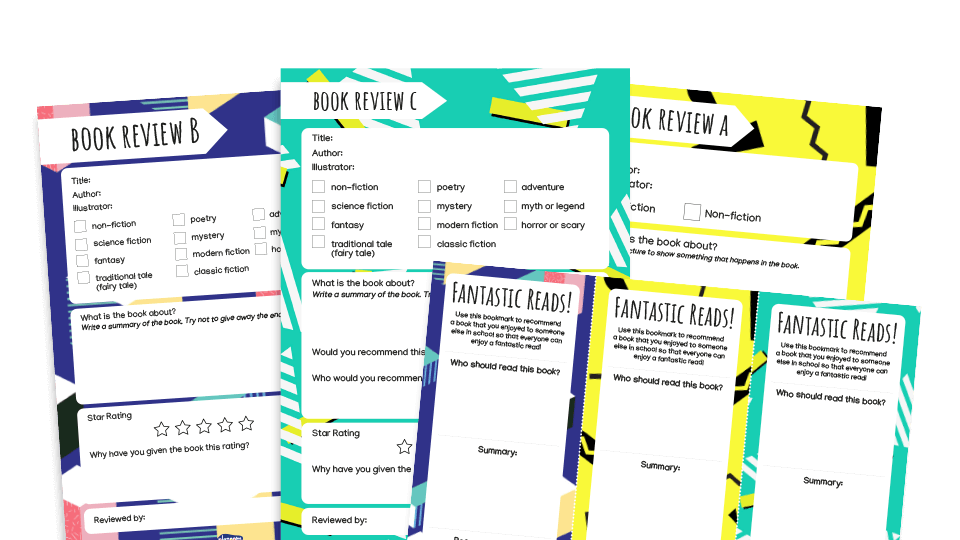
Create a love of reading in your school by using this set of fantastic free book review templates from literacy resources website Plazoom.
There are three templates in all – suitable for KS1, LKS2 and UKS2. Use them to create a class or school collection of book reviews. This will encourage discussion about book choices and help pupils develop a love of reading.
Also included is a ‘Fantastic Reads!’ bookmark. Students can write on these and place them inside books on display in your classroom or school library. This will highlight books to pupils that are recommended by their peers and create a real buzz around reading in your school.
Reading comprehension worksheet pack
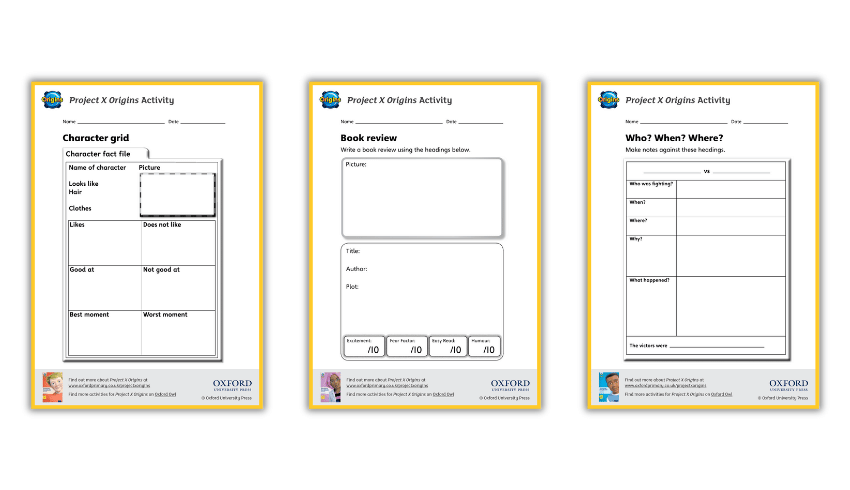
These reading comprehension worksheets from Oxford University Press help pupils to track the plot of whatever book they’re reading and take note of new vocabulary. They can also note down characters’ emotions, attributes and relationships.
Use the free worksheets to:
- create a ‘fact file’ of a book’s characters
- write a book review
- chart conflict in a story
- plus lots more
Five-word review
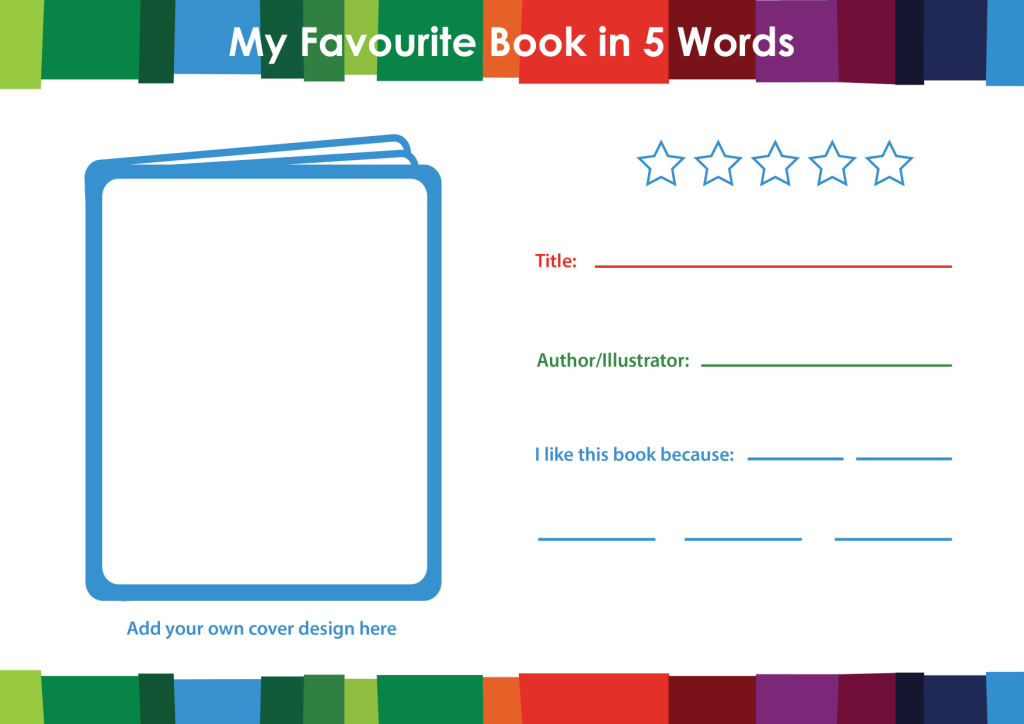
This five-word format is perfect for KS1 but you can also use it to encourage book cover creativity in KS2.
One-page template
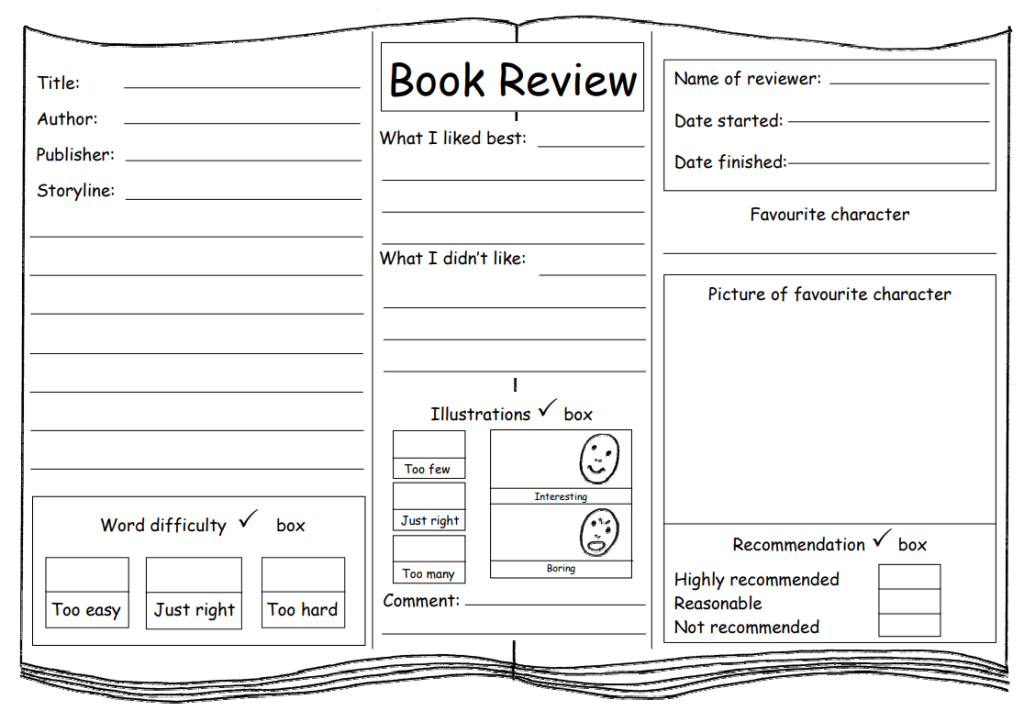
One for younger students, this nifty one-page review template asks children to fill in the key information, recap the plot and talk about what they liked and disliked. They can tick whether the reading difficulty was too easy, hard or just right.
Plus, they can draw the main character and say whether they would recommend the book to others.
Book report framework
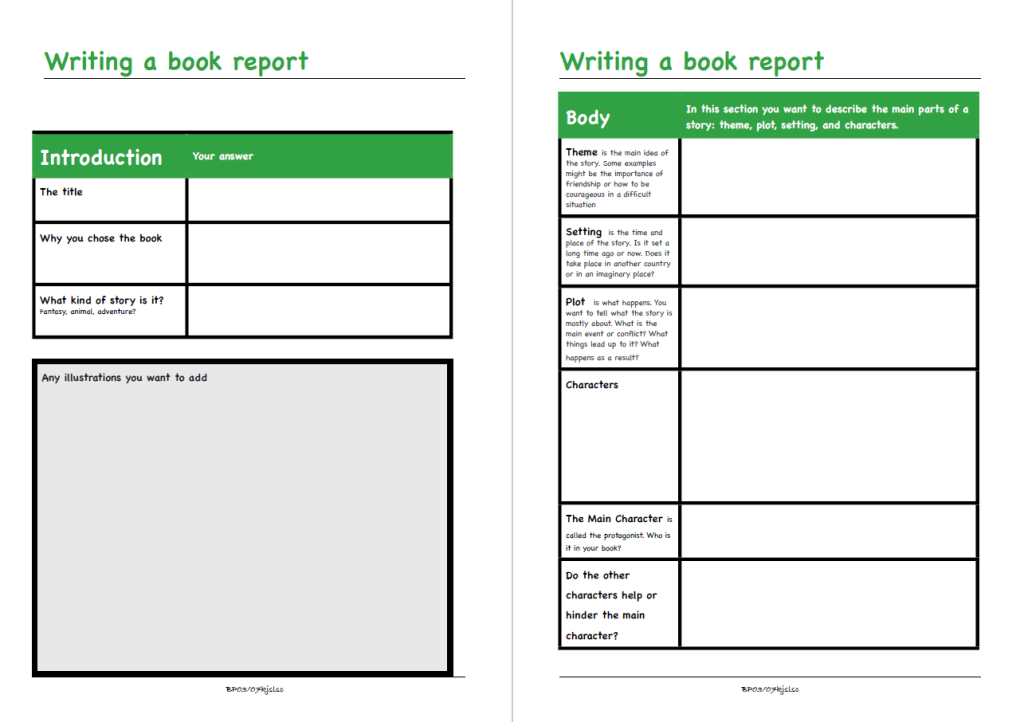
On the other end of the scale, this seven-page PDF framework helps children go into greater detail with their review. It asks about things like setting, tone, who the protagonist is, and personal things like why the child chose this book.
It also asks questions like ‘How did the story make you feel?’. Would children read other books by this author?

For a handy and concise list of things to consider when writing a book review, check out this BookTrust post . In it, author Luisa Plaja offers her top tips for how to write a brilliant review of the latest book you read – whether you liked it or not.
- Offer more opportunities for peer-to-peer recommendations , including book talk sessions. These should be child-led and allow for spontaneous recommendations.
- Help your class to create their own book trailers – these are short, animated adverts designed to encourage people to read a certain book.
- Write book reviews but give them a purpose by publishing them in your school newsletter , or similar.
- Try filming each other giving book reviews and share them with other classes in school.
- Make a ‘Book Talk’ wall in your classroom and add pictures of authors, ‘wow’ words and reviews so that anyone who’s stuck for what to read next can easily find some ideas.
Sign up to our newsletter
You'll also receive regular updates from Teachwire with free lesson plans, great new teaching ideas, offers and more. (You can unsubscribe at any time.)
Which sectors are you interested in?
Early Years
Thank you for signing up to our emails!
You might also be interested in...

Why join Teachwire?
Get what you need to become a better teacher with unlimited access to exclusive free classroom resources and expert CPD downloads.
Exclusive classroom resource downloads
Free worksheets and lesson plans
CPD downloads, written by experts
Resource packs to supercharge your planning
Special web-only magazine editions
Educational podcasts & resources
Access to free literacy webinars
Newsletters and offers
Create free account
By signing up you agree to our terms and conditions and privacy policy .
Already have an account? Log in here
Thanks, you're almost there
To help us show you teaching resources, downloads and more you’ll love, complete your profile below.
Welcome to Teachwire!
Set up your account.
Lorem ipsum dolor sit amet consectetur adipisicing elit. Commodi nulla quos inventore beatae tenetur.
I would like to receive regular updates from Teachwire with free lesson plans, great new teaching ideas, offers and more. (You can unsubscribe at any time.)
Log in to Teachwire
Not registered with Teachwire? Sign up for free
Reset Password
Remembered your password? Login here


Book Review Writing Examples
Examples: learn from the efforts of others.
Learning how to write strong reviews takes time and not a little effort. Reading the reviews others have done can help you get a feel for the flow and flavor of reviews.
If I Never Forever Endeavor Review by Hayden, age 4, Southeast Michigan Mensa

This book was about a bird who didn't yet know how to fly.
The bird has to decide if it will try to fly, but it was not sure if it wants to. The bird thought, "If I never forever endeavor" then I won't ever learn. On one wing, he worries he might fail and on the other wing he thinks of how he may succeed. He worries that if he tries, he may get lost in the world. That makes him want to stay in his nest where he's safe.
I think this book would help other children to learn that trying new things can be scary, but sometimes when we try, we can find things that make us happy too. And this book will help others know that mistakes are okay and part of learning.
My favorite part is that the bird tried and learned that she could fly. I also liked that I read this book because it gave me a chance to talk to mom about making mistakes and how I don't like making them. Then I learned they are good and part of learning.
Boys and girls who are 3 to 8 years old would like this book because it teaches about trying a new thing and how it's important to get past being scared so you can learn new things.
I give the book 5 stars since I think it's important for other children to learn about courage.
Flesh & Blood So Cheap Review by Umar B., age 8, Central New Jersy Mensa

I liked this book. People who are interested in national disasters and US history as well as immigration will most probably be interested in reading this book.
Readers can gain knowledge of what it was like to work in New York City in the early 1900s. One of the things that was especially interesting was that there were no safety laws at work. Also, there was a big contrast between the rich and the poor. Some people may not like this book because it is very depressing, but it is an important event in history to remember.
This book was very well written. It has black and white photos along with descriptions of the photos. These photos give us a better idea of what people's lives were like. This book is suitable for 9-20 year olds.
I give this book 5 stars.
Galaxy Zach: Journey to Juno Review by Young Mensan Connor C., age 6, Boston Mensa

Journey To Juno is the second book of the Galaxy Zack series. It is just as good as the first one. It's awesome!
Zack joins the Sprockets Academy Explorers Club at school. They fly on a special trip to Juno, a new planet no one has ever visited. Zack gets paired up with Seth, the class bully, and that's dreadful but Zack is excited when he finds a huge galaxy gemmite. A gemmite that large had not been found in 100 years! Kids will love this book!
Boys and girls will both like it. It's an easy chapter book with pictures on every page. I love the illustrations. I think ages 6-8 would like this but younger kids would like the story being read to them.
My favorite parts are the galactic blast game (it is similar to baseball except there are robots playing), recess at Zack's school where everything is 3-D holographic images, the rainbow river in a crystal cave on Juno, and the galaxy gemmite that Zack finds on Juno. I also loved when a life-size holographic image of his Earth friend appears in Zack's room because he calls him on a hyperphone. I give this book one hundred stars! There is a "to be continued" at the end so you have to read the next book see what's in store. I can't wait to find out what happens!!!
I Capture the Castle Review by Lauren W., age 17, Mensa in Georgia

Dodie Smith's novel I Capture the Castle is a journey through the mind of a young writer as she attempts to chronicle her daily life. Seventeen-year-old Cassandra Mortmain has recently learned to speed-write, and she decides to work on her writing skills by describing the actions and conversations of those around her.
Cassandra lives in a fourteenth-century English castle with an interesting cast of characters: her beautiful older sister, Rose; her rather unsociable author father and his second wife, artist-model Topaz; Stephen, the garden boy; a cat and a bull terrier; and sometimes her brother Thomas when he is home from school. One fateful day they make the acquaintance of the Cotton family, including the two sons, and a web of tangled relationships ensues.
While I definitely recommend this book to other readers, I would recommend it to older teenagers, mainly because it will resonate better with them. The writing is tame enough that younger teens could also read it, but most of the characters are adults or on the verge of adulthood. Older readers would take the most from it since they can not only relate, but they may also better pick up on and appreciate Cassandra's sometimes subtle humor.
Over the course of the novel, Cassandra undergoes a definite transformation from child to mature young adult, even though it's only over the course of several months. I love that I could see into her mindset and read exactly what she was feeling when she thought out situations. Her thoughts flowed well and moved the book along very quickly.
Cassandra's narrative voice is wonderful. She is serious at times, but also very witty, which makes for an engaging read. It feels absolutely real, as though I'm reading someone's actual journal. Sometimes I forget that I am reading a story and not a real-life account. Her emotions and the dialogue are so genuine, and they are spot-on for a seventeen-year-old girl in her situation.
Cassandra has many wonderful insights on life, on topics ranging from writing to faith to matters of the heart. I personally have had some of the same thoughts as Cassandra, except Ms. Smith was able to put them into words.
Capture the Castle should be essential reading for aspiring writers, those looking for historical fiction or romance, or anyone who loves reading amazing classic books. Dodie Smith is an exceptional writer, and I Capture the Castle is a book that will never become obsolete.
Frankenstein's Cat Review by Zander H., age 12, Mid-America Mensa

I appreciated Frankenstein's Cat for its fascinating explanation about the often baffling subject of bioengineering and its sister sciences. Emily Anthes explains the many sides of today's modern technology, such as gene modification, cloning, pharmaceutical products (from the farm), prosthesis, animal tag and tracking and gene cryogenics. This book provides a well-rounded summary of these complicated sciences without being boring or simply factual. Her real world examples take us on a journey from the farm, to the pet store and then from the pharmacy to the frozen arc.
Have you ever wondered if the neighborhood cat is spying on you? Read about Operation Acoustic Kitty and find out if this feline fantasy fiction or fact. Do you think bugs are creepy? What about a zombified cyborg beetle? Is Fido so special that you want two of him? Money can buy you an almost exact copy of your pooch BUT don't expect the same personality. Emily Anthes makes you crave more information. She makes you want to know the future of Earth's flora and fauna, as well as humanity itself.
I would highly recommend this book to anyone who desires a guide to the future of biological science and technology. Frankenstein's Cat is best read by the light of a glow-in-the-dark fish, while cuddling your favorite cloned dog and drinking a glass of genetically modified milk.
About Marsupials Review by Connor C., age 6, Boston Mensa

About Marsupials is the title so the book is about...marsupials, of course. It's non-fiction. I really think everyone would like the book. I think someone who likes animals would especially like to read it.
The glossary of facts in the back of About Marsupials is the most useful part. I thought the most interesting parts were that some marsupials have their pouch at their back legs and one marsupial, the Yellow-footed Rock Wallaby, is very small but can jump 13 feet wide!
Kids in the 4-8 age range would like this book. Even though it's not a story book, 4 year olds would like the few words on each page and they would love the beautiful pictures. But older kids would like it because of all the facts in the back of the book. There's a lot of information for each animal. I think boys and girls (and parents) would enjoy reading it. This book is very interesting. I give it 4 stars.
Mapping the World Review by Umar A., age 10, Central New Jersey Mensa

Every day, people around the world use maps. Whether it is an airplane pilot or businessman, housewife or museum group, maps have always and will continue to provide useful information for all.
Mapping the World talks about the uses of maps, as well as how to differentiate between the type of map projection and type of map.
In this series, we travel to the past and learn about historical mapmakers, from Claudius Ptolemy (who stated the idea that the Earth is at the center of the universe) to Gerardus Mercator (who created one of the most widely used map projections) and more. This series goes into tremendous detail on the cartographer's life and maps. We then journey to the present era to learn about map projections and the diverse types of maps used today. You might ask, "What is the difference between the two? They sound the same to me." No map projection is perfect, because you cannot really flatten a sphere into a rectangle. An uncolored projection could be used in many ways. We could use it for population concentration, highways, land elevation, and so many other things!
For example, we could make a topographic map of the U.S., which shows land elevation. We could make it a colorful map that shows the amount of pollution in different areas, or it could be a population map, or it could even be a map that shows the 50 states, their capitals and borders! Our last step in this amazing excursion is the near future, where we see some hypothetical solutions as to what maps will be used for. Currently, we are working on better virtual map technology.
Now, scientists have been able to put maps on phones. Back in the early 1900s, people had to lug a lot of maps around to find your way from place to place, or just keep asking for directions. Now, all the information is on a phone or global positioning system (GPS). It is amazing how much maps have changed technology and the world in this century.
The Mapping the World 8-book set goes into amazing levels of detail. It is a long read, but it gives an immense range and amount of information that you would not find in any other book or series on maps. The flowing way the chapters and books are organized makes it easy to link passages from different books in this series together. Mapping the World is a treasure box, filled with the seeds of cartography. Collect and plant them, and you soon will have the fruits of cartography, beneficial to those who want to be cartographers. Use this series to the utmost, then the fruits of mapping will be sweet for all who endeavor to succeed in cartography.
This series of lessons was designed to meet the needs of gifted children for extension beyond the standard curriculum with the greatest ease of use for the educator. The lessons may be given to the students for individual self-guided work, or they may be taught in a classroom or a home-school setting. Assessment strategies and rubrics are included at the end of each section. The rubrics often include a column for "scholar points," which are invitations for students to extend their efforts beyond that which is required, incorporating creativity or higher level technical skills.
- International
- Schools directory
- Resources Jobs Schools directory News Search

Writing a Review
Subject: English
Age range: 11-14
Resource type: Lesson (complete)
Last updated
15 March 2024
- Share through email
- Share through twitter
- Share through linkedin
- Share through facebook
- Share through pinterest

English Writing Teaching Resource
This upper KS2/lower KS3 teaching resource guides pupils through the process of writing a review to develop their non-fiction writing skills. Content includes:
- A PowerPoint presentation
- Activities to support the teaching of this objective
- 3 accompanying worksheets
Tes paid licence How can I reuse this?
Your rating is required to reflect your happiness.
It's good to leave some feedback.
Something went wrong, please try again later.
This resource hasn't been reviewed yet
To ensure quality for our reviews, only customers who have purchased this resource can review it
Report this resource to let us know if it violates our terms and conditions. Our customer service team will review your report and will be in touch.
Not quite what you were looking for? Search by keyword to find the right resource:

IMAGES
VIDEO
COMMENTS
KS2; Writing a book review. Part of English Comprehension Year 3 Year 4. Save to My Bitesize Remove from My Bitesize. ... You can write your answers down on paper, or discuss them instead. 1.
Help KS2 learners to write a comprehensive book review using this template as a guide to help organise their ideas. Explore this template and more exciting English resources by creating your very own Twinkl account! The template enables them to reflect on the book in a number of ways, prompting them to: Illustrate their favourite scene. Write a synopsis. Write about who they would recommend ...
Use this brilliant checklist in order to help children learn how to write a book report (KS2). Sign in to leave a review. The list of questions provides children with tools to guide them writing a book review or proofreading their book review or a peer's book review. This is very useful for my students at grade 4 and 5.
The real value of crafting a well-written book review for a student does not lie in their ability to impact book sales. Understanding how to produce a well-written book review helps students to: Engage critically with a text. Critically evaluate a text. Respond personally to a range of different writing genres.
Help your KS2 classes develop their writing skills by teaching them how to write a book review (KS2) with our extensive range of resources. Explore our extensive collection of book review templates to help children their work, bookmarks to encourage reading and reading book questions to support comprehension.
A KS2 book review template. Use this template to write your book review. What was the book about? Share a few plot details.
Help KS2 learners to write a book review using this template as a guide to help organise their ideas. Used for World Book Day. This is an excellent starting sheet for KS2, those preparing for 11+ find it easy to progrss to the more advanced sheet. It also encourages younger children to review what they have read.
Age range: 7-11. Resource type: Worksheet/Activity. File previews. doc, 33.5 KB. These two Book review templates,will help your pupils to start to building great book reviews of their own in no time. The first form, guides them with questions to answer. Once confident they can progress to the second sheet which is blank. Sheets are graded for KS2.
KS2 Review Primary Resources. Encourage KS2 children to get creative and write a review on their favourite book or film using our fabulous writing frames which outline what key features of a review they should include. You could set KS2 children a homework task to watch a specific film or TV programme and write a review following our detailed ...
doc, 92 KB. pdf, 636.37 KB. Year 3/4 English - writing a book review lesson plan and other resources: - writing a book review lesson plan. - writing a book review model review. - writing a book review writing frame. There is a PDF of all of the files and an editable version of each file (you just need to delete the watermark logo from each of ...
2. Competent Critical Thinking. Writing a book review is a chance to examine literature and digest it in a more complex way than simply following the story and understanding its plot. Compile a list of questions to help children think critically about the book they're reading and draw conclusions based on both facts and feelings.
Free book review templates. Writing book reviews enables pupils to offer opinions based on first-hand experiences. This free download, most suitable for KS1, contains three separate book review templates to choose from.. Use these free 'My Favourite Book' review worksheets to encourage children to talk about and recommend their favourite book to others.
Writing a creative and in-depth book review. Encourage children to begin writing a review (KS2 or KS1) with this creative book review template. The worksheet enables them to reflect on the book by illustrating a cover for it, and by thinking about the different events in the book. They will be asked to consider: plot. setting.
Examples: Learn from the efforts of others. Learning how to write strong reviews takes time and not a little effort. Reading the reviews others have done can help you get a feel for the flow and flavor of reviews. This book was about a bird who didn't yet know how to fly. The bird has to decide if it will try to fly, but it was not sure if it ...
Writing a creative and in-depth book review. Encourage children to begin writing a review (KS2 or KS1) with this creative book review template. The worksheet enables them to reflect on the book by illustrating a cover for it, and by thinking about the different events in the book. They will be asked to consider: plot. setting.
In this video, Twinkl Teacher Aimee, gives ideas on how to get the most out Twinkl's book review resources using our fantastic book review resources. https:/...
Writing a Book Review. Subject: English. Age range: 11-14. Resource type: Worksheet/Activity. File previews. pptx, 68.2 KB. Basic powerpoint about how to write a book review. Not quite what you were looking for? Search by keyword to find the right resource:
Book Review Template KS2 - Help your children to write the best book review they can with this creative book review worksheet. The worksheet enables them to reflect on the book by illustrating a favorite scene from it, and by thinking about who else would enjoy the book and w. Used for World Book Day.
Our Book Review Writing Frame Booklet provides your KS2 class with a full template to write their very own book review. We've included lined space to complete this writing activity, and even a space on the cover to draw their very own picture. This handy template is also useful to be printed out and completed again!
This upper KS2/lower KS3 teaching unit guides students through the process of writing a review in an engaging and detailed way. It is made up of a 30 slide PowerPoint presentation with 6 accompanying worksheets and includes numerous planning and guidance lessons and activities. An excellent way to help KS2/3 students develop their non-fiction ...
1. Start with a couple of sentences describing what the book is about. But without giving any spoilers or revealing plot twists! As a general rule, try to avoid writing in detail about anything that happens from about the middle of the book onwards. If the book is part of a series, it can be useful to mention this, and whether you think you'd ...
The mixture of different question types ensures that no matter how your pupils learn best, there's a way for them to fully express their thoughts on a book in their reviews. This book review template is a flexible tool that works equally well as an in-class or homework assignment, or even as a tool to support an external reading scheme for ...